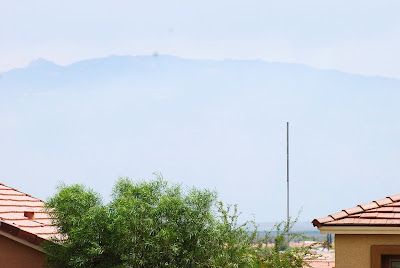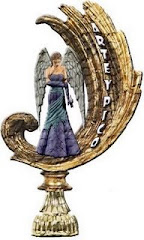
I was sitting at the computer in the den when Gus called to me from the kitchen. “I think I just saw a rat walk across the patio!”
"It could be," I answered. Then I went to see for myself. Since I am the resident expert on all things to do with nature, he relies on me for stuff like that. Sure enough, there behind the gas grill and an empty pot a pointy face with big ears and beady eyes stared at us, nose twitching. So this is what Blossom has been trying to tell us about for the last two weeks or more. She would hurry out the door and run down on the side of the house where the AC unit is, a place she normally avoids. Gus goes outside and tires to chase the creature away. He stamps his feet and yells a bit. It darts off the brick patio and down onto the dirt on the north side of the house where the AC unit is partially hidden by a half wall about 4 feet in height. Past the AC unit is the end of the block wall that encompasses our back yard. In the center of this wall a decorative block is built into the base with openings to let the water drain out during the Monsoon. Gus thinks the rat has run out this opening, so he covers it with two large stone blocks left over from building the sitting wall on our patio. Then, he thinks again. He sees the drainage pipes that the landscapers have installed beneath the brick patio and figures the rat might have gone up one of those. I am doubtful, but Gus grabs the hose and drags it over to one of the drains and turns it on. It is then I notice the blocks in front of the only escape route.
I walk over to remove the blocks, still voicing my doubts to Gus but pointing out that this was a bad idea to block up the only escape route, just in case the animal did emerge from the end. As soon as I turn around I see that pointed face with big ears and two beady eyes staring at me from the end of the drainpipe as water pours out. I am terrified of rats and I‘m sure I screamed as I bolt back to the patio and the rat retreats inside the pipe, water or not!

At this point I take over the hose end of the operation and Gus goes over to keep watch on the end of the pipe. Sure enough, once again the rat emerges, thoroughly soaked. And in the water that flows from the pipe dozens of rat dropping float. It has been living in that pipe for awhile.
Gus grabs a nearby shovel to herd the creature towards the opening at the end of the block wall. It darts behind some leftover lengths of drainage pipes. Gus grabs the pipes and lifts them up. The rat runs towards him. He hollers and swings the shovel. The rat retreats. I decide to use the water canon method that worked so well with the beetles that covered the mesquite tree last week and so I join the fray and point the hard jet of spray straight at the creature. In fear it climbs the half wall near the AC unit with the agility of Spiderman. I train my hose on it and it leaps like superman across the compressor! Then, instead of retreating out the opening in the block wall, it returns towards us.

We cannot believe our eyes. Gus yells and swings. I scream and spray. Rat climbs the wall and leaps again. Then, in a last ditch effort to return to the only safe place it knows, it comes straight at us. I’m screaming. Gus is yelling. He catches the rat on the end of the shovel and tries to fling it over the wall. It falls off and surges onward. He swings again and the shovel comes down on the rat’s head. With tears in his eyes and fear in his heart, Gus brings the shovel down again and again. I hear the guttural sounds of his fight. Then, he scoops up the limp body and flings it over the wall into the wash. I breathe a sigh of relief as I realize it is over. For today, Gus is my hero.
As we stand there, hearts pounding, breath coming in gasps we suddenly hear a voice call out, “Did you git it?”
We look up astonished, trying to find the source of the voice. There down the street one of our friends is standing in front of his house with another unknown neighbor. Apparently, drawn by our shouts and the sights of shovels flying and water spraying, they had witnessed the whole thing.
“Did you git it? Richard asked again, a chuckle in his voice.
“Yes” Gus replied. It was a rat.
“Well, I knew it had to be a rattlesnake or a varmint,” responds Richard. “If you ever get a rattlesnake in your yard, you just call me.” Richard is a remnant from the 60’s with long hair tied back in a ponytail that hangs down his back. A welder by trade; he is a native of Arizona and very cheerful and friendly. He owns an aging black lab mix and we often see him while walking our dog. We stand there dazed as we realize the show that he and his neighbor must have witnessed from afar. In the pent up rush of adrenalin, we chuckle with relief. Then, I take the hose and flush out the other drain pipe that runs into the first one in a “Y”. More rat droppings float out from the end of the pipe in the murky water.
Gus stands there with his t-short soaked in sweat, panting. “I have to go sit down,” he says. It’s around 11:30 a.m. and we have not eaten. It is only later in the day as the adrenalin has drained from my body that I finally cry. The image of that poor creature struggling valiantly to return to the only home it knows haunts me. But it could not live in my yard. It had to go. At 2:00 a.m. this morning I awaken and write this epitaph to the rat:
Homage to a Rat
You bravely fought to make it home,
and though I’m sad you’re dead,
I’m also glad you’re gone.































 Their twisted shapes look muscular and thick as they grab onto the eroding soil of the red caliche walls. The wash curves left, then right, then flattens out again before it reaches the newly constructed bridge that will bring people and cars to the new neighborhood on the west side of the wash. At this point they are only putting in roads, but someday the pounding of hammers will be heard as more human homes invade the desert. For now, the birds and wildlife are the only residents here.
Their twisted shapes look muscular and thick as they grab onto the eroding soil of the red caliche walls. The wash curves left, then right, then flattens out again before it reaches the newly constructed bridge that will bring people and cars to the new neighborhood on the west side of the wash. At this point they are only putting in roads, but someday the pounding of hammers will be heard as more human homes invade the desert. For now, the birds and wildlife are the only residents here.


 He walks out into the center with his questioning “whoop? whoop?” When he is halfway across we spot the female at the edge of the bank.
He walks out into the center with his questioning “whoop? whoop?” When he is halfway across we spot the female at the edge of the bank. 

 A deep basin filled with riprap is on the north side of the bridge. I can only guess that it is to hold the water and debris before it overflows and continues on its way downhill. We skirt the edge of the basin and re-enter the wash again.
A deep basin filled with riprap is on the north side of the bridge. I can only guess that it is to hold the water and debris before it overflows and continues on its way downhill. We skirt the edge of the basin and re-enter the wash again.

 A Gila Woodpecker and Gilded Flicker cling to separate arms of this green monster. The spiny flesh is pocked with holes. Still, this ancient giant produces blossoms in an ever hopeful attempt to reproduce.
A Gila Woodpecker and Gilded Flicker cling to separate arms of this green monster. The spiny flesh is pocked with holes. Still, this ancient giant produces blossoms in an ever hopeful attempt to reproduce.

 They are a plain gray with no wing bars or eye rings, but they have this distinctive yellow base to their lower mandible. Gus snaps off a few photos for me in hopes that I will be able to identify the bird at home.
They are a plain gray with no wing bars or eye rings, but they have this distinctive yellow base to their lower mandible. Gus snaps off a few photos for me in hopes that I will be able to identify the bird at home.











